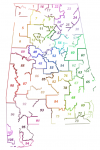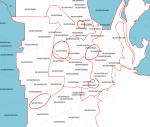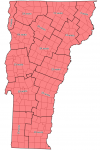Caprice
Well-known member
- Location
- Illinois, USA
- Pronouns
- he/they
You do the Lord's work and also bloody hell that's ambitious.I decided to try to write a reference book for state legislative boundaries, since there is no centralized resource.
You do the Lord's work and also bloody hell that's ambitious.


There should be a button on the menu that looks like two green blobs being stitched together. Select all of the polygons you want to merge and then click that button.It sure is ambitious. Hopefully I manage to get my way through it, hahah.
Things happened, and now I'm digitizing 1950 precinct maps, because they're the closest I can get to 1970, and they'll be relevant for my TL's electoral shenaniganry anyhow so why not.
View attachment 32471
Relatedly, can someone who's familiar with QGIS tell me how to make multiple polygons part of one entry on the attributes table? Bits of Mobile and Baldwin county are islands.
There should be a button on the menu that looks like two green blobs being stitched together. Select all of the polygons you want to merge and then click that button.



| Candidate | Slogan | Votes | Percentage | Seats |
|---|---|---|---|---|
| Gordon Persons | I Am a Regular Human Being, And Not an Alien From Mars | 137,155 | 32.84% | 126 |
| Phil Hamm | I Will Dropkick Any Interior Designers Who Attempt to Adjust the Royal Office | 56,397 | 13.50% | 50 |
| J. Bruce Henderson | I Will Move the Capital to Camden, as I Have Lived Around There My Whole Life | 38,867 | 9.31% | 44 |
| Elbert Boozer | For Anniston and For Alabama | 48,221 | 11.55% | 36 |
| Chauncey Sparks | Bourbon - I Need Not Say More | 27,404 | 6.56% | 20 |
| Bull Connor | A Conservative Voice for the People of Birmingham | 20,629 | 4.94% | 17 |
| Robert Bell | We Here in Huntsville are Up In Our Own Way | 20,171 | 4.83% | 14 |
| John S. Crowder | I Think That Someday We Should Think About How We Voted to Have a Civil War Ninety Years Ago | 15,177 | 3.63% | 9 |
| Reuben Newton | Jasper Is Not A Town to Be Joked About | 15,502 | 3.71% | 8 |
| Joe Money | Contrary to Popular Belief, I Have Never Even Been to a Bank | 10,528 | 2.52% | 4 |
| William M. Beck | I Will Live in Fort Payne for the Rest of My Years, and So Will You If I Am Elected | 10,218 | 2.45% | 3 |
| Albert Stapp | Don't Stop Stapp | 6,200 | 1.48% | 2 |
| Wiley Gordon | Blount County Regionalist | 6,073 | 1.45% | 1 |
| Hugh Dubose | Really, I Just Want to Get Into the Assembly | 2,594 | 0.62% | 1 |
| James M. Dement | For the Last Time, I Am Not Greek, You Are Thinking of Entirely the Wrong Athens | 2,030 | 0.49% | 1 |
| W. R. Farnell | I Don't Think I Am Asking For Much When I Say I Want One Percent of the Vote In Just One County | 748 | 0.11% | 0 |

